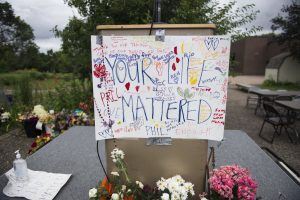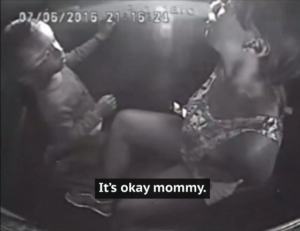by Mumia Abu-Jamal

The video is riveting.
A woman is rapt with rage, her voice slow and controlled, as a cop points his gun at her, as her lover bleeds his life away beside her, and her baby daughter is just distracted with these Bed Time Stories for Children.
Philando Castile is dying as a discussion goes on, but it isn’t with him, it’s about him.
The cop’s gun quivers and quakes, pointed at this woman, as the cop’s voice also quivers and quakes, fear thick in every breath.
The cop, Jeronimo Yanez, has just killed Philando, and he attempts to explain why. “He was moving,” he said. “He was reaching for a gun.”
Castile was reaching, his girlfriend, Diamond Reynolds, said, for his wallet, which held his driver’s license and gun permit.
Why were they stopped? Yanez said a broken tail light.
Philando Castile’s name joins a list as long as life, sacrificed on the altar of white fear.
Just hours ago, a jury relieved Yanez of his anxiety by finding him not guilty of manslaughter!
A jury believed Yanez’s tale that the Black man was a robbery suspect.
The jury believed, once again, that a Black life had no intrinsic value, and that it could be treated like trash, burned up and discarded, like an old pair of shoes.
Philando Castile’s name joins a list as long as life, sacrificed on the altar of white fear.
© Copyright 2017 Mumia Abu-Jamal. Keep updated at www.freemumia.com. His new book is “Writing on the Wall,” edited by Joanna Hernandez. For Mumia’s commentaries, visit www.prisonradio.org. Encourage the media to publish and broadcast Mumia’s commentaries. Send our brother some love and light: Mumia Abu-Jamal, AM 8335, SCI-Mahanoy, 301 Morea Road, Frackville, PA 17932.
The 395 kids Philando Castile left behind
Children are asking for answers their parents don’t have.
It was a few weeks after his death in July 2016 when Sakki Selznick learned that her daughter had been giving imaginary high-fives to Philando Castile.

Castile – or Mr. Phil, as students at J.J. Hill Montessori Magnet School would call him – often greeted students with high-fives while they waited on line to get breakfast in the cafeteria. Now that Mr. Phil was gone, Selznick’s young daughter worried she’d never get one of his famous high-fives again. One evening, she explained, she was thinking about it and she’d started high-fiving the air, hoping Mr. Phil would respond somehow.
A magical high-five didn’t arrive. Through tears, Selznick explained to her daughter that she would not be getting one.
Jeronimo Yanez, at the time a St. Anthony police officer, shot and killed Castile last summer during a traffic stop. Castile, 32, left behind not only a girlfriend and her daughter, a mother and a family, colleagues and friends, but also 395 adoring students at the Saint Paul, Minnesota, elementary school where he worked.
The students have spent the past year mourning Castile, a loss that was felt anew last week with the news that Yanez had been acquitted of any wrongdoing.
Now that Castile’s killer has been found not guilty, the young children are grappling with another uncomfortable truth: The justice system doesn’t always deliver justice.
In a country where many schools are segregated by race and class, J.J. Hill is a small bastion of diversity, a Montessori school that draws from surrounding progressive neighborhoods. About 47 percent of the students are Asian, Black or Hispanic, with a number of Somalian and Hmong immigrants. The rest of the students are white. For the most part, everyone gets along, parents say. The fact that this harmonious racial coexistence does not extend beyond the school’s four walls is a reality students had to confront when a cop killed their nutrition services supervisor last summer.
The students have spent the past year mourning Castile, a loss that was felt anew last week with the news that Yanez had been acquitted of any wrongdoing.
For some white families, it was surprising that an incident of stark police brutality could happen to someone in their circle. The shock mobilized them to action via protests and petitions. For some Black families, the reality of police violence was something for which they had long prepared their children.
But the fact that it happened to Mr. Phil – a man whom parents describe as exceedingly gentle and unfailingly kind, a man who did everything “right” – was something no one could have prepared for.
Selznick is white, but she used to live in an all-Black neighborhood in Los Angeles. She says she isn’t naive about the harsh facts of police brutality. Still, when a jury found Yanez not guilty of second-degree manslaughter last week, she felt like she had been tricked into the idea that there would be some sense of justice. Earlier reports of a deadlocked jury had given her hope. “I got snookered,” she said.
When Selznick’s 10-year-old daughter learned of the verdict, she seemed overwhelmed. She said she could no longer remember Mr. Phil’s face. Selznick’s 16-year-old son, who also knew Castile, almost put a hole through the wall in anger.
But the fact that it happened to Mr. Phil – a man whom parents describe as exceedingly gentle and unfailingly kind, a man who did everything “right” – was something no one could have prepared for.
“They’re right at the age where they believe there will be social justice,” Selznick said. “That’s a lie.”
Zuki Ellis’ son, entering fourth grade, isn’t likely to forget about Castile’s death any time soon. Ellis is Black. She’s never tried to conceal from her son the realities of racism or police brutality. But this was the first time anything had happened to someone so close.
“They’re right at the age where they believe there will be social justice,” Selznick said. “That’s a lie.”
“He has the same question a lot of us have: How does something so awful happen and no one is accountable for that?” Ellis said. “How do you kill Mr. Phil and nothing happens?”
This year, when kids at J.J. Hill had to face school without Mr. Phil, regardless of their race, some students emerged from the experience as changed individuals.
Tony Fragnito, a small business owner who is involved in local politics, says his two boys were noticeably different. They were more somber and had less energy when they got home from school. Then, in November, the election happened, building on the trauma of Castile’s death. After Donald Trump won, Fragnito’s younger son packed a suitcase and said he was moving to Canada with his Somali friends from school because “it’s not safe for them anymore.”
“He has the same question a lot of us have: How does something so awful happen and no one is accountable for that?” Ellis said. “How do you kill Mr. Phil and nothing happens?”
Andrew Karre, a children’s book editor, recalled that when his 9-year-old son found out about Castile’s death, he asked a simple but difficult-to-answer question: “Why was the police officer scared?” Karre’s son followed Yanez’s trial on public radio. When the verdict was announced, the family headed down to the Capitol to protest. Given the facts of the case, Karre said, his son was troubled by the outcome.

John Horton, a teacher at J.J. Hill who also has two kids enrolled, said Castile’s death would often come up in class. The children drew connections to Castile when learning about civil rights issues. They tried to make sense of Castile’s death in relation to a larger context of injustice. But for many, he said, it still seemed senseless.
“I think a lot of the adults are still trying to work through it, and the kids see this,” Horton said. “They see the instability and the not understanding from the adult side.”
The school has mostly dealt with the grief head-on. Teachers got special training, and counselors were available for therapy throughout the year. A handful of teachers sported pins with Castile’s face on them. There is a bench in his honor, and a tree in his name.
But some parents are still struggling to provide answers to questions they can’t figure out themselves.
“It has been a hard year,” Ellis said. “I don’t imagine the next year will be easier.”
Rebecca Klein is education reporter for the Huffington Post, where this story first appeared. Reach her via Twitter @rklein90.
Philando Castile’s skin color ended up being a death sentence
Excerpts from the June 19 report by Democracy Now!
Black Lives Matter protests are continuing in the Twin Cities after a Minnesota police officer was acquitted Friday in the killing of Philando Castile, an African-American man who was shot five times during a traffic stop last year. … We speak to civil rights lawyer Nekima Levy-Pounds, the former president of the Minneapolis chapter of the NAACP, who is now running for mayor of Minneapolis. …
Nekima Levy-Pounds: I thought that the result of the jury in finding Jeronimo Yanez not guilty was absolutely absurd, in light of the facts of the case, in light of the circumstances surrounding Philando Castile’s untimely death. And people here are outraged. …

When you look at the composition of the jury, there were 10 white individuals who served on the jury, two people of color, both of whom were young. I mean, one was an 18-year-old Ethiopian immigrant. The other was a young Black man. And when you look at that, I mean, who in their right minds would pick 10 white people in Minnesota against, you know, potentially two young people of color and having them decide a case of this magnitude? And so, some people are arguing that the prosecution made some mistakes in this case, and not playing the aftermath of Philando Castile’s death was probably one of them. …
I’m not sure who in their right minds would choose two young African Americans to serve on the jury again, one being an Ethiopian immigrant, as opposed to older African Americans, a larger composition of people of color across the board who are concerned about the phenomenon of officer-involved shooting cases, the use of excessive force in the state of Minnesota and the fact that there is a repeated pattern of failing to hold police officers accountable when they abuse the rights of citizens of the state of Minnesota. …
I am running for mayor because we’re ready to shift the paradigm in the city and to ensure that we’re actually focusing on equity, that we’re holding police officers accountable, that we’re looking at racial disparities across every key indicator of quality of life, including economics.
Democracy Now! is broadcast weekdays on over 1,300 radio and TV stations, the largest public media collaboration in the country, and at www.democracynow.org, where archived shows, transcripts, podcasts and more can also be found. This segment was broadcast Monday, June 19, 2017.

 Store
Store


